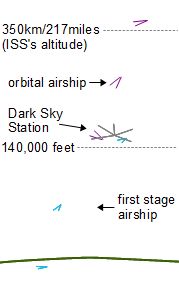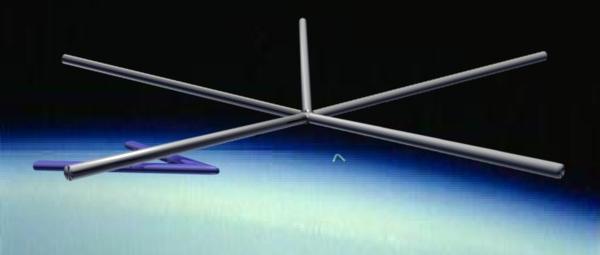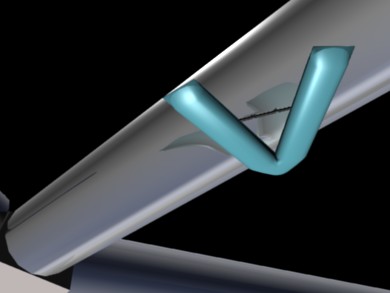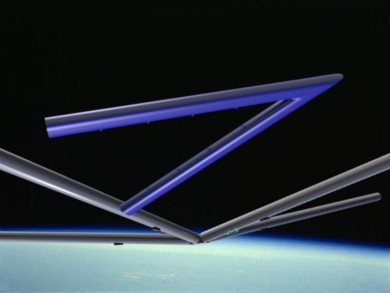JP Aerospace has a unique approach to getting to orbit, using airships. A first stage airship is used to go from the Earth's surface up to 140,000 feet, taking a few hours or so. At 140,000 feet it docks at a Dark Sky Station where passengers and cargo are transfered to an orbital airship. The orbital airship then spends a few days slowly rising and accelerating to orbital speed to an altitude where it can transfer passengers and cargo to a space station or space vehicle.
|

|
|
|
First stage airship
The first stage airship is around 800 feet long and 150 feet tall (243 meters long and 45 meters tall) and is filled with Helium as its lifting gas. Helium is used since it is non-combustible in the presence of oxygen.
To move horizontally below 110,000 feet it tilts, nose upward on a steep angle. The upward movement due to its buoyancy causes air to flow over it in such a way that it acts like a wing, much as a propeller pulls an airplane wing horizontally through the air causing lift except that the whole arrangement is rotated 90 degrees. This process is called dynamic climbing.
The airship does have two propellers optimized for efficiency at high altitude where the air is thin. Below 110,000 feet the propellers are used for maneuvering. However, above 110,000 feet the dynamic climbing trick mentioned above for horizontal propulsion no longer works and the airship levels off while the propellers take over.
Dark Sky Station
The Dark Sky Station is stays at 140,000 feet and is over 12,000 feet (4 kilometers) in diameter in order to provide the necessary buoyancy in the thin atmosphere. It is capable to housing around 200 people. It uses hydrogen as its lifting gas. Hydrogen is combustible in the presence of oxygen but there is not enough oxygen at this altitude to be a danger.
Orbital airship
The orbital airship flys between the Dark Sky Station at 140,000 feet and up to orbital altitudes where it can rendevous with space stations or space vehicles. It never returns to Earth. It is around 6000 feet (1.8 kilometers) long and uses hydrogen for its lifting gas.
To get up to orbital velocity, 17,500 mph (28,000 kph), it uses electric propulsion engines. The engines do not have to provide lift as do engines for typical Earth-to-orbit rocketships, just forward thrust. The acceleration is slow, taking days to get up to speed, so high thrust chemical rocket engines are not needed.

The Airship to Orbit program
The above describes an actual, active program under development. JP Aerospace, under the guidance of John M. Powell and with the assistance of many volunteers have spent a large amount of time since 1993 doing over a hundred missions, building, testing and flying hardware to the edge of space. You can find out more on their website here.
All information above was gathered from the book "Floating to Space - The Airship to Orbit Program" by John M. Powell where the above and much more is detailed, including the history and progress of the development of this program.
Airships in the comics - ESCAPE FROM TERRA
And now these ships have made it into online comics. Check out this page from the ESCAPE FROM TERRA strip. A Dark Sky Station in Venus's upper atmosphere and an orbital airship but for going from atmosphere to atmosphere (i.e. planet to planet) instead and referred to as V-ships. Awesome looking too, as you can see from the snipet below taken from page 723.

|




